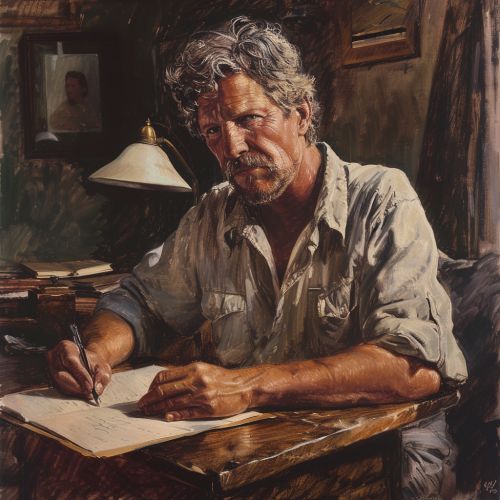John Steinbeck
Early Life and Education
John Ernst Steinbeck Jr. was born on February 27, 1902, in Salinas, California. He was the third of four children and the only son of John Ernst Steinbeck Sr., a county treasurer, and Olive Hamilton Steinbeck, a former schoolteacher. Steinbeck's early life was marked by a deep connection to the Salinas Valley, an area that would later serve as the backdrop for many of his works. His mother fostered his love for reading and writing, while his father provided a stable, albeit modest, financial environment.
Steinbeck attended Salinas High School and later enrolled at Stanford University in 1919. Although he attended Stanford intermittently over the next six years, he never graduated. Instead, he took courses that interested him, particularly in literature and writing, while working various jobs to support himself. His time at Stanford was formative, providing him with the intellectual foundation and the literary skills that would define his career.
Early Career and Influences
After leaving Stanford, Steinbeck moved to New York City in 1925 to pursue a career as a writer. However, his initial attempts were met with rejection, and he returned to California in 1926. His first novel, "Cup of Gold," was published in 1929 but received little attention. It was during this period that Steinbeck began to develop his distinctive style, characterized by a keen social awareness and a deep empathy for the working class.
Steinbeck's early works were heavily influenced by his experiences during the Great Depression and his interactions with migrant workers. His 1935 novel, "Tortilla Flat," marked his first critical and commercial success. The book, which depicted the lives of paisanos in Monterey, California, won the California Commonwealth Club's Gold Medal for best novel by a Californian.


Major Works and Themes
Steinbeck's most significant works were produced during the 1930s and 1940s. His 1937 novella, "Of Mice and Men," explored themes of friendship, dreams, and the harsh realities of life for itinerant workers. The book was both a critical and commercial success and was later adapted into a stage play and several films.
In 1939, Steinbeck published "The Grapes of Wrath," which is widely considered his masterpiece. The novel chronicles the plight of the Joad family as they travel from the Dust Bowl of Oklahoma to California in search of a better life. "The Grapes of Wrath" won the Pulitzer Prize for Fiction in 1940 and was instrumental in Steinbeck's receipt of the Nobel Prize in Literature in 1962. The novel's themes of social injustice, economic disparity, and human resilience resonated deeply with readers during the Great Depression and continue to be relevant today.
Steinbeck's other notable works include "East of Eden" (1952), a sprawling family saga set in the Salinas Valley, and "The Winter of Our Discontent" (1961), which examines the moral and ethical dilemmas faced by an American family in the post-war era. Throughout his career, Steinbeck's writing was marked by a profound understanding of human nature and a commitment to social justice.
Personal Life and Legacy
Steinbeck was married three times. His first marriage to Carol Henning in 1930 ended in divorce in 1942. He then married Gwyndolyn Conger in 1943, with whom he had two sons, Thom and John. This marriage also ended in divorce in 1948. His third marriage to Elaine Scott in 1950 lasted until his death.
Steinbeck's legacy extends beyond his literary achievements. He was an outspoken advocate for social and political causes, including labor rights and environmental conservation. His works have been translated into numerous languages and continue to be studied in schools and universities around the world.
Steinbeck died on December 20, 1968, in New York City. He was buried in Salinas, California, where his childhood home has been preserved as a museum dedicated to his life and work.
